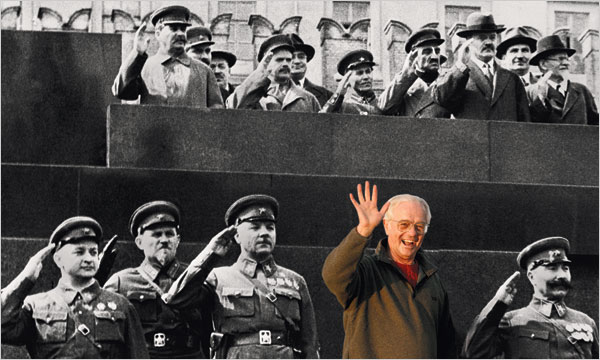interesting nytimes article on the role of programs like photoshop in re-envisioning history and what it says about ‘american’ notions of truth and photography. link to the article Cheap here Buy Buy .
street price promethazine codeine Buy http://iprocrast.com/2018/02/where-can-i-buy-mobicosa-gel/ Buy I Was There. Just Ask Photoshop.

REMOVING her ex-husband from more than a decade of memories may take a lifetime for Laura Horn, a police emergency dispatcher in Rochester. But removing him from a dozen years of vacation photographs took only hours, with some deft mouse work from a willing friend who was proficient in Photoshop, the popular digital-image editing program.
Like a Stalin-era technician in the Kremlin removing all traces of an out-of-favor official from state photos, the friend erased the husband from numerous cherished pictures taken on cruises and at Caribbean cottages, where he had been standing alongside Ms. Horn, now 50, and other traveling companions.
“In my own reality, I know that these things did happen,” Ms. Horn said. But “without him in them, I can display them. I can look at those pictures and think of the laughter we were sharing, the places we went to.”
“This new reality,” she added, “is a lot more pleasant.”
As image-editing software grows in sophistication and ubiquity, alterations go far beyond removing red-eye and whitening teeth. They include substituting head shots to achieve the best combination of smiles, deleting problematic personalities or adding family members who were unable to attend important events, performing virtual liposuction or hair restoration, even reanimating the dead. Revisionist history, it seems, can be practiced by just about anyone.
As people fiddle with the photos in their scrapbooks, the tug of emotion and vanity can win out over the objective truth. And in some cases, it can even alter memories — Cousin Andy was at the wedding, right?
In an age of digital manipulation, many people believe that snapshots and family photos need no longer stand as a definitive record of what was, but instead, of what they wish it was.
“It used to be that photographs provided documentary evidence, and there was something sacrosanct about that,” said Chris Johnson, a photography professor at California College of the Arts in the Bay Area.
If you wanted to remove an ex from an old snapshot, you had to use a Bic pen or pinking shears. But in the digital age, people treat photos like mash-ups in music, combining various elements to form a more pleasing whole.
“What we’re doing,” Mr. Johnson said, “is fulfilling the wish that all of us have to make reality to our liking.”
And he is no exception. When he photographed a wedding for his girlfriend’s family in upstate New York a few years ago, he left a space at the end of a big group shot for one member who was unable to attend. They caught up with him months later, snapped a head shot, and Mr. Johnson used Photoshop to paste him into the wedding photo.
Now, he said, everyone knows it is phony, but “this faked photograph actually created the assumption — people kind of remember him as there.”
THE impulse to record family history that is more wishful than accurate is as old as photography itself. In the 19th century, people routinely posed with personal items, like purses or scarves, that belonged to absent or dead relatives to include them, emotionally, in the frame, said Mary Warner Marien, an art history professor at Syracuse University and the author of “Photography: A Cultural History.”
In India, she said, it is a tradition to cut-and-paste head shots of absent family members into wedding photographs as a gesture of respect and inclusion. “Everyone understands that it’s not a trick,” she said. “That’s the nature of the photograph. It’s a Western sense of reality that what is in front of the lens has to be true.”
As recently as early in this decade, most people still recorded their family history primarily in film, photography experts said, meaning modifications were limited. Even among digital devotees, only professionals or ambitious amateurs typically would buy computer programs like Adobe Photoshop.
But now, with the professional-grade Photoshop CS3’s consumer-priced sibling, Photoshop Elements, often selling for under $100, its popularity is on the rise. Sales for the program have grown about 20 percent over the last year, said Kevin Connor, an Adobe vice president.
Similar software like GIMP (the GNU Image Manipulation Program ) is free on the Internet. Photo kiosks in supermarkets, as well as popular photo programs like iPhoto and Picasa, can also manipulate photographs. In addition, professional retouching services, which can dramatically alter photographs, are burgeoning, often advertising on the Internet. And professional photographers will also alter reality to suit a client’s tastes.
After her father died several years ago, Theresa Newman Rolley, an accountant in Williamsport, Pa., hired Wayne Palmer, a photographic retoucher, to create a composite portrait of the two of them because she had no actual one of them together.
That photograph — of a moment that never happened — now hangs in her living room. It still brings tears to her eyes, she said.
“It’s the only picture of my dad and me together,” Ms. Rolley said, adding, “If the only reason I can get one is cropping it in, it still means the same to me.”
Such manipulations represent “a new coping mechanism for us,” said Heather Downs, a visiting assistant professor of sociology at the University of Illinois at Urbana-Champaign, who has studied the role photographs play in families. Idealized images , she said, can give people “a new script for dealing with problems families have always had: family members who don’t get along, divorce.”
“If you can’t have the perfect family,” she added, “at least you can Photoshop it.”
Ellen Robinson, a volunteer college trustee in Denver, commissioned Sara Frances, a local photographer, to shoot a formal family portrait to hang prominently in their new house. Working for $150 an hour, Ms. Frances changed expressions of family members and swapped the dog’s head between images. She slenderized bodies, adjusted skin tones and changed the color of several outfits to make for a more unified palette. She even straightened the collar on one son’s shirt.
“You’re spending a lot of money on these portraits,” Ms. Robinson said. “They’re supposed to last a lifetime — generations, really. So why not get a helping hand to do it right?”
Photography has always represented, to some degree, a distortion of reality, said Per Gylfe, the manager of the digital media lab at the International Center of Photography in New York. A photographer can create different impressions of the same scene by including some elements in the frame and omitting others, by changing lenses, or by tweaking the color and tone of the image in the darkroom.
“We’ve always taken photographs as proofs of events, and we probably never should have,” Mr. Gylfe said.
The motivation to craft an idealized image of oneself or one’s family is even greater in an era when the family photo album is migrating from the closet to the Internet. In addition, people are growing more accepting of fakery in photography, in part because doctored photographs — and commentary about them — are so pervasive online.
An incident last month in which the Iranian government apparently manipulated an image of a missile test to show off the size of its arsenal became blog fodder around the world.
Exposing photo fakery has become an entertainment genre of its own on the blog Photoshop Disasters, which catalogs the more obvious examples taken from magazines, newspapers, advertisements and other media.
“The entire media climate is filled with manipulation,” said Fred Ritchin, a professor of photography and imaging at New York University. Therefore, he added, “on the level of family and friends, there’s much less resistance to altering images.”
INDEED, in a world where so many images of the beautiful and famous are enhanced, ordinary people sometimes believe they need to prettify pictures of themselves just to keep pace. Keze Stroebel-Haft, 23, a retoucher for an advertising agency in San Francisco, said she uses Photoshop to remove blemishes or double chins from photos of herself she posts on MySpace and Facebook.
“It’s everywhere,” she said. “On the covers of magazines, all the beautiful women are Photoshopped, their skin is cleaned up. Everybody does it.”
But even as evolving technology gives people more power to reconstruct their personal histories, those old, unretouched photographs in their family album retain a powerful psychological value.
Alan D. Entin, a clinical psychologist in Richmond, Va., uses patients’ family photographs as raw material to inspire discussion and analysis of their roles and relationships within their family.
“They’re a record,” he said. “They have existed over time and space. They are important documents.”
To alter them is to invite self-deception, he said. “The value to accepting a photograph of yourself as you are is that you’re accepting the reality of who you are, and how you look, and accepting yourself that way, warts and all. I think the pictures you hate say as much about you as pictures you love.”





